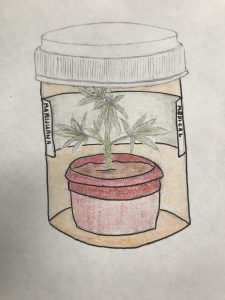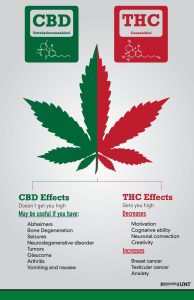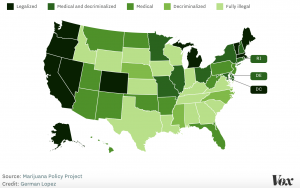
What is Medical Marijuana?
Medical marijuana is the use of cannabis to treatment various diseases although the U.S. Drug and Administration (FDA) has not approved the plant a use of medication. There are two major components of marijuana, cannabinoids (CBD) and tetrahydrocannabinol (THC). THC is the major psychoactive chemical, that gives individuals the feeling of “high” while CBD is the derivative of cannabis that is typically used to treat the disease. In addition. there are over 100 different known types of CBD contained within marijuana that bind to different receptors throughout the entire body. The human body also produces chemicals that bind to these same receptors, called endocannabinoids.

Image 1: This image shows the differences between the two majors components in marijuana, CBD and THC
Source: https://www.pinterest.com/pin/448319337891247374/
Since marijuana is considered a schedule one drug, which means that is is considered to have no medical uses, although there appears to be some evidence to the contrary. Some large clinical trials have shown that the benefits of marijuana and the diseases that it treats outweigh the negative effects. This classification makes it difficult for researchers to find new medications or treatments. Despite this, there are two FDA approved medications that contain CBD, but no THC, that are used to increase appetite and reduce nausea.
What is Medical Marijuana used to treat?
Medical marijuana can be used to treat, not cure, many different illnesses and disorders including:
- Multiple Sclerosis — a disease that affects both the brain and spinal cord due to the death of myelin sheaths in the CNS often has medical marijuana prescribed to lower the severity of relapses and pain associated with the disease.
- Cancer — while cannabis is not a cure for cancer, it is often used for those who are undergoing chemo treatment by acting as an appetite stimulant and fighting nausea.
- HIV/AIDS — medical marijuana works to improve the quality of life for those diagnosed with HIV/AIDS, much like the way that cannabis acts as a treatment for cancer through appetite stimulation and reducing pain.
- Epilepsy — cannabis products, especially those having higher CBD concentrations, are shown to lower the frequency of seizures as well as the severity.
- Many more (see Image 1 for more examples)
Where is Medical Marijuana Legal?

Image 2: As of Nov. 14th 2018, these are the states that have legalized medical and recreational marijuana.
Source: https://www.vox.com/identities/2018/8/20/17938366/medical-marijuana-legalization-states-map
The image above shows the states that have legalized both medical and recreational marijuana usage. As mentioned earlier, the federal government still considers marijuana as a class one drug which means that is either subject to change or the dozens of states that now have laws that allow marijuana in one form or another will have marijuana become illegal again. However, it appears that more and more states are not only legalizing medical marijuana but recreational as well. This trend may lead to the eventual nationwide legalization and decriminalization of marijuana.
Guidelines that Doctors often follow
Although there is variation between doctors and how they prescribe medical marijuana in different situations there does appear to be some strategy that is followed by some. In 2017 the Medical Board of California as well as governor Jerry Brown created a pamphlet for doctors to follow when prescribing medical marijuana. Included in the pamphlet is the flowchart that is seen below.

Image 3: A flow chart that some doctors may follow when deciding to prescribe marijuana.
Source: http://www.blog.greatzs.com/2017/11/how-to-prescribe-medical-marijuana.html
Also, because of the classification of marijuana there is no direct way for doctors to “prescribe” it as they would any other drug. Instead they become certified and recommend patients that qualify. Usually before recommending a patient for medical marijuana, the doctor forms a relationship with them in an effort to not just become what is often known as a “marijuana mill” and just give the recommendation to all who come through. Other information that must be taken into consideration when recommending medical marijuana such as
- The patient’s history with other drugs.
- How long will the patient being taking the medication.
- Does the patient know the risks of being under the influence while driving and other possible risks?
- Knowing the CBD and THC content (if any THC content) and where and how they are going to obtain it.
- Any possible side effects, if combined with other drugs the patient is taking.
It inevitably boils down to the individual’s situation and the doctor who is prescribing the medication. There are many guidelines and different standards that people may follow.
Sources:
10 Most Common Conditions Medical Cannabis Is Prescribed For
https://www.drugabuse.gov/publications/drugfacts/marijuana-medicine
https://www.ncbi.nlm.nih.gov/pmc/articles/PMC1071601/
https://www.mdlinx.com/internal-medicine/article/2548